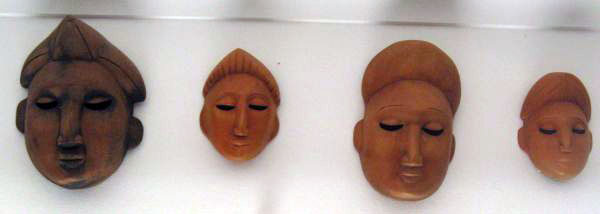
DAVID & BERNARD'S ART COLLECTION - A DISCURSIVE TOUR
Introduction
From 1958 until the early years of the 21st century,
we assembled what is now a diverse collection of paintings,
sculpture and objets, mainly, but not entirely, from Africa. In most cases
we met the artist. Now, at the original suggestion of Anne-Marie Shawe, I
am writing an account of how and where we acquired our pieces and also
giving you something of the background. Some sections are
included in my memoir, Brokie's Way.
1. PAINTINGS
Bernard and I,
separately, bought three paintings in 1963. When Bernard was a
post-graduate student at Indiana University, he became friendly with a
young undergraduate, David Rodgers, who had - to the concern of his family
- switched his major from astronomy (reputable) to art (uncertain).
Bernard bought David's striking self-portrait, which has
graced our bedroom in three continents. Bernard bought this both because
he liked it, and also to encourage David.

David Rodgers - Self portrait (100 x
72 cm)
Meanwhile, I spent the first three months of 1963 at Oxford, writing up my D.Phil dissertation. I often had a drink with Godfrey Lienhardt, a very talented anthropologist, who accompanied me to an art exhibition, encouraging me to buy (seven guineas) an oil painting by Stanley Simmons of the main court of my college, Wadham College.

Stanley Simmons
Wadham College
I spent two post-graduate years 1949 to 1951 at Wadham College, after my undergraduate time at Christ's College, Cambridge. Wadham and Christ's have a loose association. This painting has accompanied me on all my travels since, making three transatlantic trips as well as seven moves, mostly in rattling three-ton GT (Government of Tanganyika) lorries, in the early 1950s. When I drew Godfrey’s attention to the tilt of the painting, he said, with some justification, “ That is what the tower looks like to you, after a night out with me”.
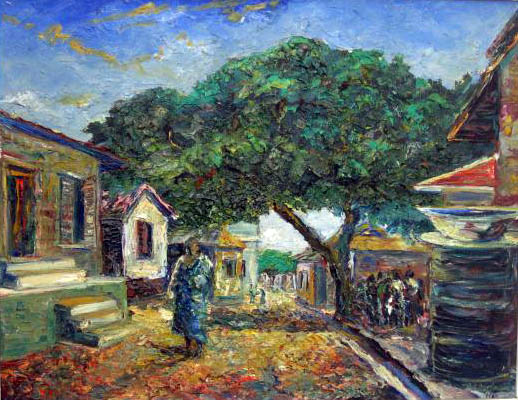
Mr Bartimeus
Street Scene (51 x 62 cm)
A few months later, when I was in my last days of my fieldwork at Larteh, Ghana, I commissioned (for the first - and last - time) a painting. I asked Mr. Bartimeus, a local schoolmaster, to paint a Street Scene, which shows the side road which I crossed every day, with the inevitable group of elders, discussing town matters, in the background. For six guineas, this was a good investment. A guinea was a common British monetary term, which was adopted in the British Empire. One guinea = one pound and one shilling.

Twins
Seven-seven
Spiritual Mother (100 x 88 cm),
In 1968, I was on a research project in Africa, and was able to visit Nigeria and Rhodesia (as it then was) specifically to look at contemporary African art, with a view to buying selected pieces, using my father's legacy. (See Brokie's Way, pp 230 - 242). My visit to my friend, the historian Michael Crowder, at
the University of Ife, coincided with an exhibition of Contemporary Nigerian Art which gave me a
splendid opportunity to acquire selected paintings. The artists were young
Yoruba (all male) who had relocated, at Crowder's invitation, from
Oshogbo, in Yorubaland.
Twins-Seven Seven, one
of the best-known contemporary African artists, was born in Nigeria in
1944; he has written an autobiography and is the subject of a
biography. (Ulli Beier (ed.) A Dreaming Life: An Autobiography of Twins Seven-Seven. Bayreuth: Bayreuth African
Studies,1999. Henry Glassie: Prince Twins Seven-Seven: His Art, His Life in Nigeria, His Exile in America. Bloomington, Ind: Indiana University Press. 2010).
Twins "named himself Twins Seven-Seven. Seven times he came into the world, each time as one in a set of twins. Six times he returned to the spirits who sent him, but after the seventh birth his mother managed....to keep him on the earth" (Glassie: 2010.1) Twins is a
colourful person, having a reputation not only as an artist, but also as a
singer, musician, dancer, and politician - the last role compelled him to
flee Nigeria and settle in the USA.
On
June 6,1968 I bought Twins' Spiritual Mother,
for fifteen guineas. This painting, gouache on brown paper, depicts the ghost mother calling back her children, who can be born again. This is a common theme in Yoruba folklore, and can be found in the novels of Chinua Achebe and Ben Okri. The exhibition ran for three days; after it closed, Twins arrived at Michael Crowder's home, on his motor-bike, carrying his rolled up painting.
Other paintings bought at this exhibition include:
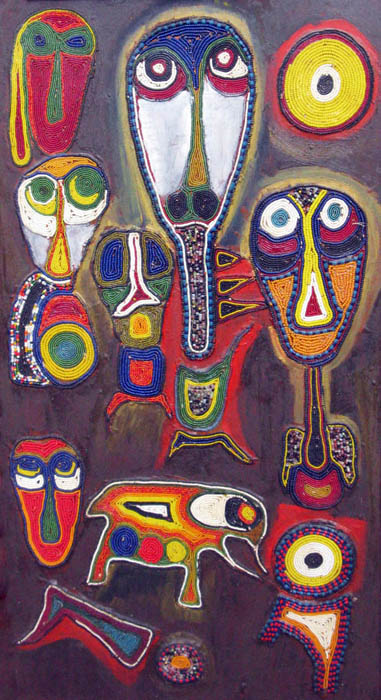
Jimo Buraimoh
Oshogbo and its Founders (75 x 40 cm) 20 guineas, beads and oil.
After this visit, I met Jimo in Ibadan,
and accompanied him in a hair-raising taxi drive to Lagos, to the 5-star Federal Palace Hotel, where Jimo's mural was prominently on display. Jimo had not seen the installation and after examining it, we went in the hotel for lunch. The (Nigerian) head porter, in an impressive Ruritanian uniform, initially refused to admit us, because neither of us wore ties ( in very high temperature and humidity!) and Jimo, then 20 years old, and looking much younger, was wearing shorts, and looked like "a small boy", to use that contemptuous West African expression for a person of no consequence. I had what Bernard would have called a "controlled tantrum", told the unbelieving porter that Jimo was one of Nigeria's major artists, demanded to see the manager, and eventually we were - reluctantly - seated at a table near the kitchen.
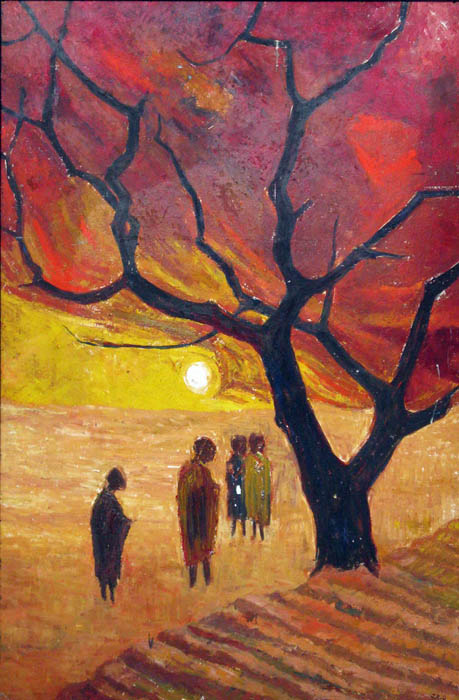
F. Ojo
Arid Landscape (120 x 80 cm) 25 guineas
Ojo, a lecturer at the University of Ife, was
the only artist in this group who had had formal training. The Oshogbo artists may have been subtly influenced by their "patron", Ulli Beier, but they were never enrolled in any institution.

G.Talaki
Mallams (55 x 95 cm ) 17 guineas.
This is one of our favourite pictures, always hanging in our bedroom. When Monica Wilson (a distinguished professor of social anthropology, and my first anthropology mentor) stayed with us, we gave her our bedroom, and she told us that she loved waking up to look at the wise mallams. (A mallam is a respected Muslim religious teacher.)
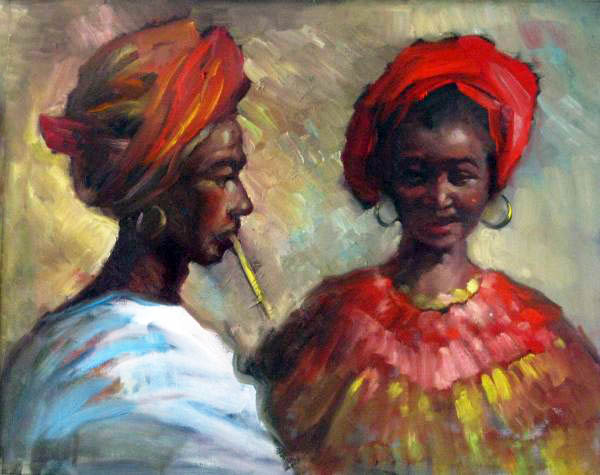
Wolof women
Dakar (60 x 75 cm)
After our harrowing time in 1975 when I was arrested in connection with our Rhodesian sculptures (see Brokie's Way:
230-238), we drove to San Francisco for a week-end of R & R. Our
friend Tom Livingston, an antique dealer, invited us to join him at
an art auction, where we both liked a painting of two Wolof women,
probably painted in Dakar, Senegal. (The Wolof live in
Senegal, many of them living in Dakar, the capital. The women are noted
for their elegance, and their gold jewellery.)
This was my first - and last - bidding at an auction, and I nodded when the auctioneer suggested he start at $25. No-one else bid, so we bought this framed painting at a bargain price. On the back of the painting, nearly obliterated, was a Polish name, presumably of the artist, but we have no other clues of its provenance.

Jak Katarikawe
Mapenzi Mapya "New Love" (60 x 90 cm)
When we were doing fieldwork in Kenya in the 1970s, we used regularly to check out the Paa ya Paa art gallery in Nairobi, where contemporary African artists were displayed. We bought Jak Katarikawe's Mapenzi Mapya ("New Love").
Jak, an engaging young man from Uganda, had painted this work while in Tanzania (Dar es Salaam), and was showing it in Kenya. He explained (in Swahili) that the Arab man is propositioning an African girl (the tray holds an embracing couple); Na yeye anasema labda (and she is saying "perhaps"). She certainly has a very "labda" look. When we were at the University of California, Santa Barbara, our friend Irma Cavat, from the Art Department, was very taken by this painting; she was amazed when we told her that it had been done by an untrained young man from Uganda. Irma thought it was "very SoHo-ish", referring to the fashionable artists' colony, "SOuth of HOuston", in New York City.
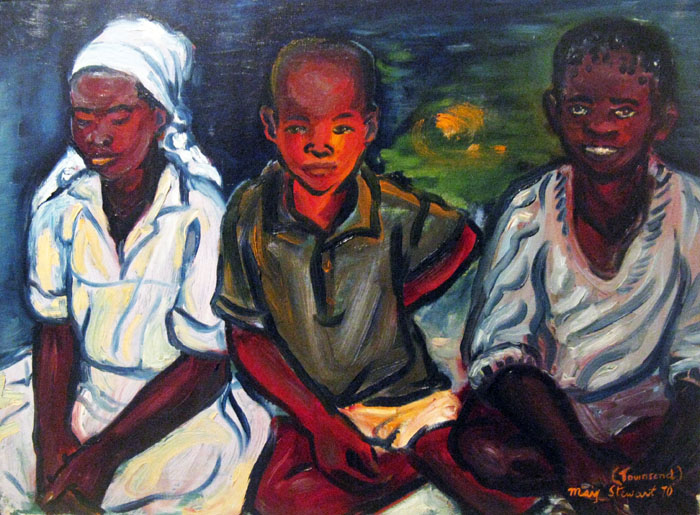
Mollie Townsend
Three Motswana Children (48 x 60 cm)
Mollie Townsend has lived in Zambia, Botswana and South Africa. Nearly 90 years old, she is still painting, in a variety of styles and media. I am familiar with Mollie’s work ,and I particularly like her False Bay seascapes. On May 11, 2011 I went with friends to Mollie’s Fish Hoek home for lunch and to see her paintings. I was firmly resolved not to buy anything, because I have run out of wall space. But I could not resist this oil painting, done in 1970, in Botswana.

Thelma Sanders
Seven Swahili women (57 x 42 cm)
It was in Kenya that we met Thelma Sanders and - over the years - we bought several of her fine lithographs. Bernard's favourite was her Seven Swahili Women, and I liked her Porcupine.

Thelma Sanders
Porcupine ( 40 x 50 cm)
Thelma accompanied us on a trip to West Africa in 1988, when Professor Kwame Arhin, another old friend, arranged for us to visit the Asantehene (the king of the Ashanti) at Kumasi; learning that the king's totem was a porcupine, Thelma gave him the original of this lithograph.

Lucy Wiles
Mother and child (39 x 55 cm)
Staying with my brother Paul in Greytown, KwaZulu/Natal, in 1986, we met a local artist, Lucy Wiles and later bought two of her portraits of Zulu women. At first we were looking for paintings by Africans, but many of those - at that time - were either politicized "victims of apartheid" - or stylized "traditional Zulu women". Some painters produced erotic depictions of nearly naked young women - none of these were to our taste, but Lucy Wiles' ladies such as her Mother and child - were refreshingly contemporary, and had a simple dignity.
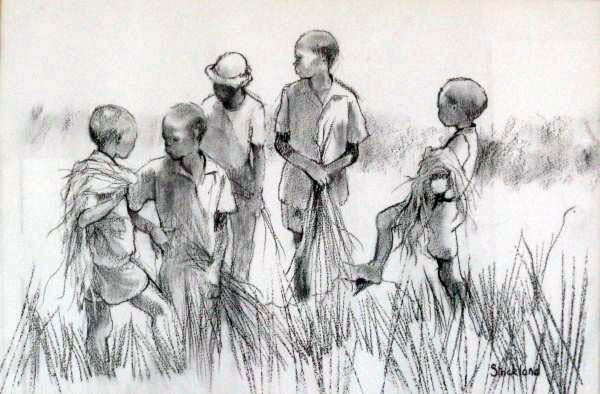
Strickland
Bafana (36 x 56 cm)
Similarly, the painting by Strickland of five naughty young Zulu Boys - Bafana, appealed to us for its realism. The youngsters seem to be planning some mischief, while they gather reeds.
In 1990, our first full year of retirement, we made a two month trip to Australia. My cousin, Peter Brokensha, also an anthropologist, had studied an aboriginal group, the Pitjantjanjara, near Alice Springs. Peter arranged for us to visit the Papunya Tula Artists' shop in Alice, where we bought Mary Dixon Nungurray's Snake and Witchetty Grub Dreaming for A$ 1,550.

Mary Dixon Nungurray
Snake and Witchetty Grub Dreaming (135 x 90 cm)
Bernard had
particularly wanted a painting by an Aborigine woman. This is our
largest painting and has pride of place in our living room. When we collected this large painting from the framer in Islington, it just fitted into the London taxi.
We visited Sicily in 1991, staying a few days in Palermo with Gabriela, a friend of Anne-Marie Shawe. Bernard and I proposed to visit the Muzeo Nazionale: whenever we visited new cities, we liked to check out the major art galleries and museums. Gabriela was concerned about our safety, because the museum is in a rough part of town. (Much of the surrounding area had not been rebuilt since the Allied bombardment before the Allied invasion in 1943).

Antonello da Messina
The Palermo Annunciation (27 x 18 cm)
At Gabriela's insistence, we went with no cameras, watches and with little cash: in the event, we had no problems. The highlight of our tour of the Museum was one painting, The Palermo Annunciation, by Antonello da Messina (1430 - 1479) - of whom neither of us had heard. The painting of the Virgin stood on an easel in the middle of a room - the only painting in the room. Both of us felt immediately overwhelmed by the simplicity, the beauty, the radiance. So many medieval depictions of the Virgin are - at least to our tastes - sentimental and unconvincing, but this bowled us over with its realistic portrayal of a serene and stunningly beautiful young woman. We bought a postcard of this luminous painting, which we later had enlarged. (On the train journey to Sicily, I had been reading The Last Leopard, David Gilmour's biography of Giuseppi Tomasi di Lampedusa, and we were able to identify Lampedusa's Palermo family home Palazzo Lampedusa, which is now divided into upmarket vacation rental units; the grand house is on the seafront, quite near the museum. Lampedusa’s book, The Leopard was made in 1963 into a famous movie, directed by Visconti and starring Burt Lancaster).
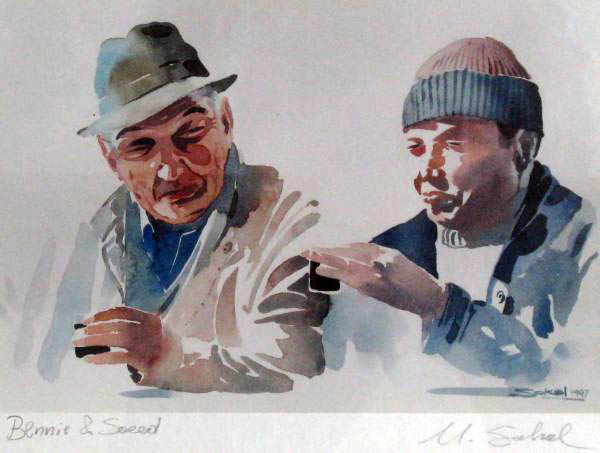
Moise Sokal
Bennie and Saeed,(16 x 25 cm)
While living in Sherborne, Dorset, in the 1990s, we met Moise Sokal, an Israeli artist who lived near us, in Somerset. We bought three of his paintings, including a striking portrait of Bennie and Saeed, drinking coffee.
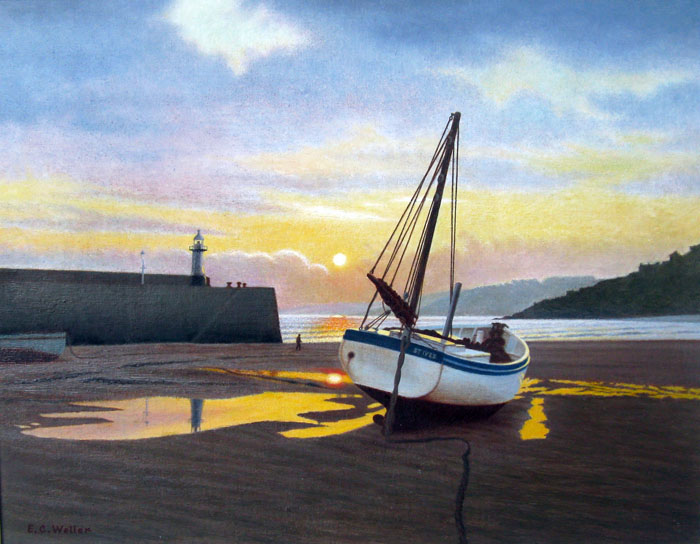
Edward Weller
Morning Glory, St.Ives, Cornwall (40 x 50 cm).
During our 1984-1986 stay in London, (directing the Education Abroad Program of the University of California) we visited Cornwall, my “ancestral home”, several times. Francis Carne Brokensha, my father’s father, left St Just in Penwith, in 1870 to seek – and make – his fortune in “Port Natal” (now Durban). St.Just is rather a nondescript small town, formerly a mining centre. Five miles away is the long established, pretty artist’s colony of St.Ives. On a visit here in 1985, after inspecting the studios of sculptress Barbara Hepworth, and ceramicist John Leach, we found this pleasing seascape at a local gallery.
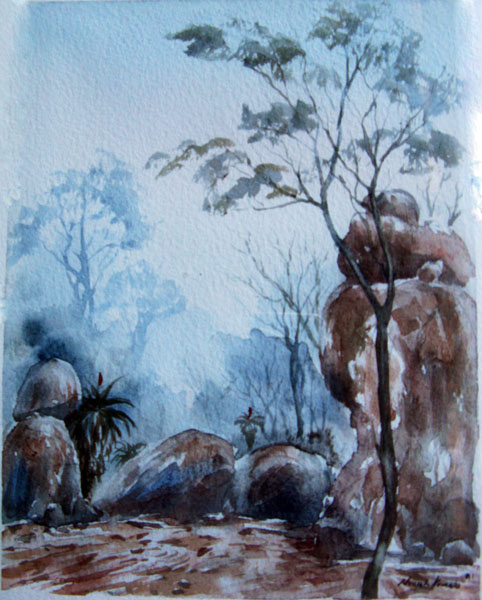
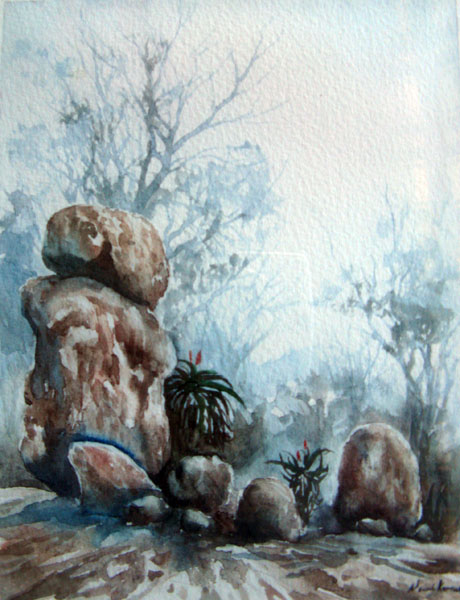
Nouah Kumalu
Two Matopos scenes (45 x 22 cm.)
Rhodes Matopos National Park was established in 1926 with a bequest from Cecil John Rhodes, whose grave is here. When we lived in Bulawayo (1956-1959) we frequently came to this Park (an hour’s drive), for a picnic, and to enjoy the magnificent rocks and the grand sweeping views. My sister-in-law, Lizzie Brokensha, who lives in Bulawayo, took Bernard and me and our friend Harriet Carter for a week-end at a hill top chalet in this great park (now called the Matobo National park) in 1991. Knowing how much we had enjoyed our visit, she gave us these water colours by a local ( Ndebele) artist, Nouah Kumalu. As is the case with much of our collection, to look at these scenes creates many resonances, many happy memories, nearly all of them in the company of Bernard.
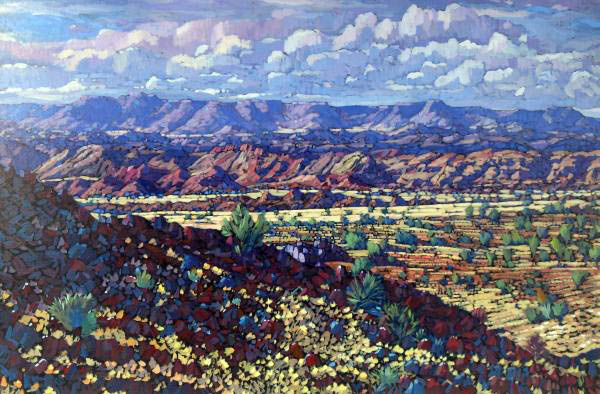
Mike Cloran
Outeniqua, Northern Cape , (90 X 60 cm)
Since moving to South Africa in 1999, we have bought only a few works - the painting by Mike Cloran of Outeniqua, Northern Cape, (Rand 2300) (above), which we had visited in 2001, and Zulu artist Selina Makwana's embroidered cloth, ADM AND EFA THE RIVEVER IN BABILON, a charming naïve scene.
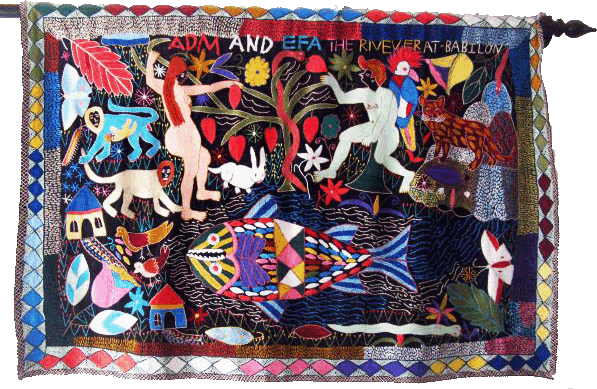
Selina Makwana
ADM AND EFA THE RIVEVER IN BABILON (130 x 85 cm)
We bought this cloth (Rand 2,150) at the annual exhibition of "Innovative Threads", in Nova Constantia, Cape Town. It hangs on the wall to greet you as you come into my home. I now wish that I had also bought a charming companion piece, "Mr. and Mrs. Mandela having tea"
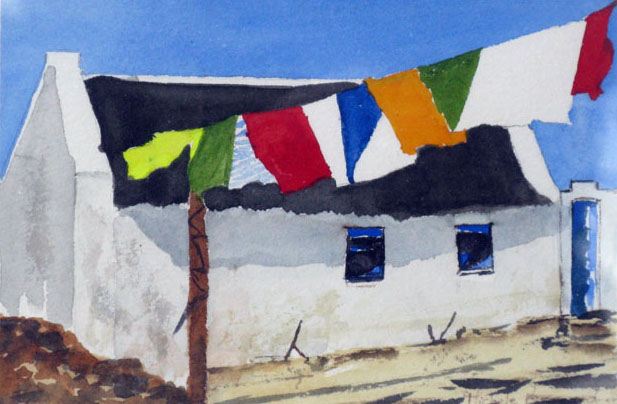
Michelle Brouard
House at Arniston (11 x 17 cm)
Michelle Brouard, a friend from our Catholic church, painted a charming water-colour, House at Arniston, reminding us of happy stays at David and Elspeth Jack's welcoming beach house there. Another two acquisitions (and there is no more space on the walls) were both landscapes of David and Elspeth Jack's "magical" Appelsdrift Farm, in the Overberg (which I visited regularly, both before and after Bernard's death).
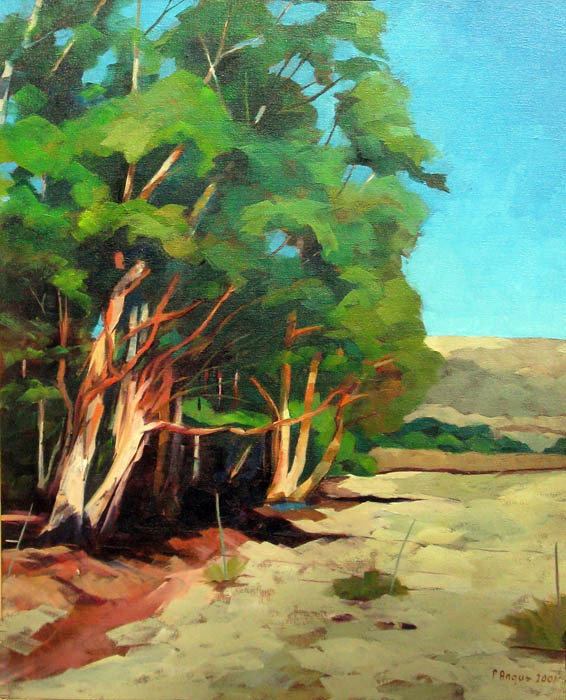
Prue Myers
Overberg Landscape (54 x 44 cm)
One, is by Prue Myers, a "swallow" who comes out from London each year to spend a few months at Arniston. I made countless visits to Appelsdrift, my favourite evening walk, with the excited dogs - took me past these eucalypts, and on to the little stone bothy on the border of the farm. I used to rest there, check on Bernard's memorial tree, an African olive, and enjoy the sunset.

Alice Goldin
(27 x 32 cm)
The other is by Alice Goldin, a well-known local artist , who, at nearly 90 years old, is still painting. Alice, who divides her time between Cape Town, Arniston and Paris, produces landscapes and tree-scapes that are much sought after.
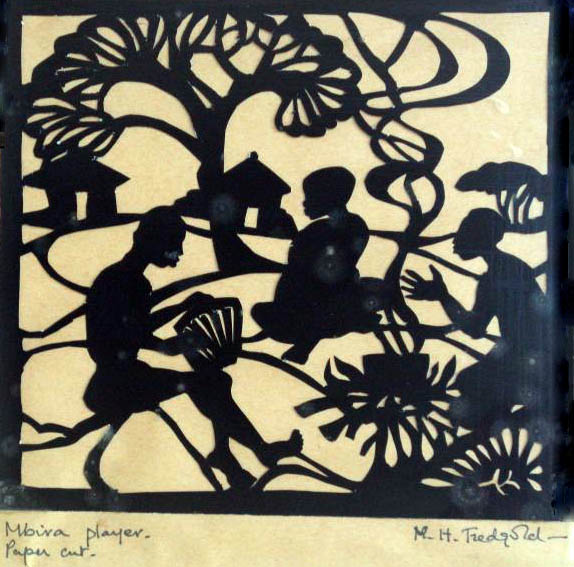
Margaret Tredgold - Mbira player ( 20 x 20 cm)
Finally Lady Margaret Tredgold gave us a small cut-out of her mbira player. Now 100 years old, Margaret, whom I met at Appelsdrift, is the widow of Sir Robert Tredgold, Governor of Rhodesia and of the Federation of Rhodesia and Nyasaland. He resigned in protest at the discriminatory policies. Margaret is, in her own right, renowned as a botanical painter.

Donald Gill
Birthday party (40 x 120 cm)
I include Donald Gill's collage of my 2010 87th cyber-birthday party. Donald modeled this on the famous Grammy Award-winning cover, by Sir Peter Blake, of the Beatles' 1967 album, Sergeant Pepper's Lonely Hearts Club Band, including not only my family and friends but also two famous visitors, Nelson Mandela and Mahatma Gandhi.
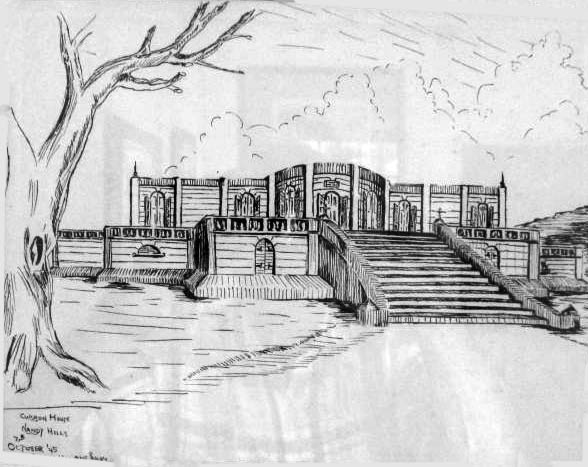
Bernard Riley
Cubbon House (22 x 29 cm)
Finally, here is a black and white sketch that Bernard did, in 1945 (when he was 19 years old) of Cubbon House, Nandi Hills. At the time, Bernard was with British Army Intelligence, stationed in Bangalore. When we visited that city in 1988, we drove (65 kms) to see Cubbon House, which has 18 rooms and was built by Lord Cubbon, then Viceroy of India, in the 1860s, as a summer retreat. The house, now a guest house, Nehru House, looked little changed from Bernard's sketch.
2. SCULPTURES
(a) Stone
Our collection of 35 stone sculptures from Zimbabwe, includes those from my initial purchase at the National Gallery in Salisbury (now Harare) in 1968, and another five that we bought in later years. The first set belongs to what is known as "the first generation" (of Zimbabwean - or Shona - sculpture). The first generation sculptors made mostly representational works, although many were of spirit animals or birds or persons, that is figures with characteristics both human and animal - or bird. Later sculptors followed different paths , some becoming more abstract and some showing more western influences.

Fidelis Nyahangare
Pangolin (22cm)
Fidelis Nyahangare's Pangolin was selected by the Natural History Museum of Chicago for a post-card, when we lent the museum eight of our sculptures for an exhibition of "Contemporary African Art". Another of our stone sculptures is of two pangolins, and we also have a realistic wooden pangolin.
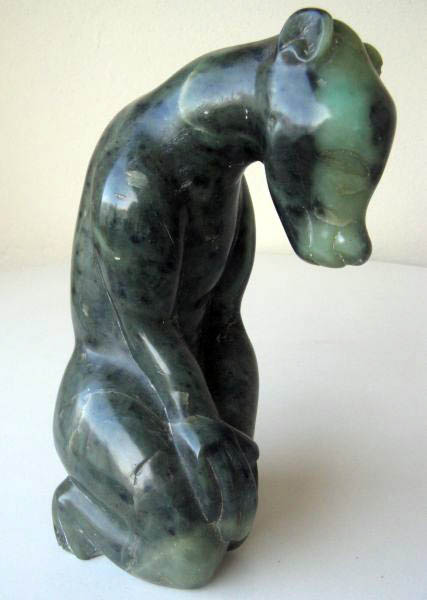
John Takawira
Animal man (30cm)
John Takawira is one of the best known of the first generation sculptors, his Animal Man being a good example of his delicate work. John is the nephew of Joram Mariga (see below); John's son, Gerald, is also a sculptor, as is his brother Bernard (see below).

Newert Kanonama
Fish (34 cm)
We came across very few fish among all the Zimbabean sculptures, whether museum quality or roadside work. Newert Kanonama's Fish, is both unusual and striking. Our late friend Dr.Jerome Rupp, a much loved physician living in Ojai, California, mentioned our collection to his friend Baron Rothschild, who was also a keen collector of Shona sculpture. (There are several Baron Rothschilds; this one lived in Italy and France, occasionally visiting New York. He had come to California specifically to consult Jerome about a medical problem.) When the baron examined our collection, he made two remarks: first, he told us that we spoiled the impact of the major pieces by cluttering the room with rubbish; he suggested that we spot-light a few choice works. Second, he said that if ever we wished to part with Newert's Fish, he would like to buy it.

P.Manjoro's
Baboon fighting Man (55 cm)
P.Manjoro's Baboon fighting Man is one of our most dramatic sculptures, the agony on the man's face being very evident. One interpretation is that the man had done a disgraceful act (such as sleeping with his brother's wife) and is being punished by supernatural powers, a victim of sorcery.

Joyce Manyandure
Bird (27 cm)
Joyce Manyandure is one of the few women in the first generation, and her Bird
is a fine example of her work. Colleen Madodombe is the best known of Zimbabwe's women sculptors; her distinctive style has often been copied by sculptors of lesser talent

Old cobbler (34 cm)
My brother Paul and his wife Lizzie visited us in Santa Barbara the early 1980s, bringing a sculpture of an old cobbler. Although this is not of museum quality, nor is it signed, it has been one of our favourites, both for sentimental reasons, also for its accurate, sensitive portrayal of a simple cobbler.

Henry Munyaradzi
Spirit Medium (30 cm)
When we lived in London, 1984-1986, and during the 1990s, we bought three more sculptures, two of them by first generation artists. Henry Munyaradzi (known as "Henry of Tengenenge") was one of the best-known of all in the group, and his Spirit Medium (above) is powerful. In the past, the Shona relied much on mediums, who were in touch with the ancestors, and who advised and guided them: even in the Liberation war of the 1970s, mediums had great influence. We bought this piece in 1984 at an exhibition at the Commonwealth Institute in Kensington, London, when Henry was present. When we met him, Henry insisted on carrying the work to our car, despite our protests. Although by then he was well known, and his work was selling well - we paid £1250 for the Spirit Medium - Henry remained a modest and unassuming man.

Cosmos Kamhiriri
Chapungu (32 cm)
We had not heard of Cosmos Kamhiriri until 1986, when Bernard popped into a gallery near Piccadilly, and was very taken with Cosmos' Chapungu and rushed back to our flat in Kennington, to persuade me that we must buy this sculpture. We both loved this work, because of its beauty, and also because Chapungu means a bateleur eagle, a splendid bird which is almost our "totem", it has a special significance for us. A final factor was that it is carved from a rare stone, golden verdite.

Bernard Takawira
Calling for a missing partner (35 cm)
Bernard Takawira (the younger brother of John T) was an unusually tall man, with whom my Bernard got on very well, partly because of their shared name. In 1994, we went to an exhibition of Zimbabwe art in an unlikely setting, in the little Somerset town of Street, where we bought Bernard Takawira's opalstone Calling for a missing partner (above). When we bought it, I had a foreboding - because Bernard already had serious medical problems - that it would eventually have a sombre significance for me. In the event, we shared a further ten rewarding years, and I now regard this sculpture calmly, with appreciation of all that my "missing partner" and I did together.
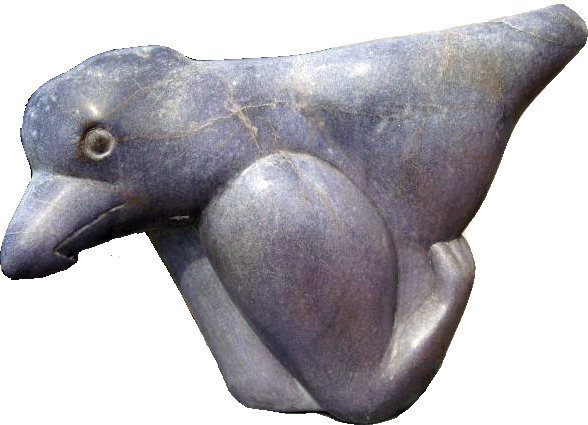
Joram Mariga
Gondo Gwarikari (32 cm)
We met Joram Mariga, who was known as "the father of Zimbabwe sculpture" in 1991 at Chapungu, Roy Guthrie's workshop/gallery in Harare. We bought Gondo Gwarikari (martial eagle), a striking piece in mauve lepidolite.

Daniel Mariga
Frog (35 cm)
We later bought at Kirstenbosch National Botanic Garden (which has a permanent display of Zimbabwe Sculpture), another lepidolite sculpture, by Joram's son Daniel Mariga - Frog. Like fish, frogs are very rarely depicted in this genre.

Stephen Damanyi
Baby Rabbit (22 cm).
About twice each year, I polish our Zimbabweans sculptures, using –at Joram Mariga’s suggestion - Cobra Wax Polish, a standard household item. I enjoy this task, because it renews my acquaintance with my old friends, and they are all so tactile. Damanyi’s rabbit is truly charming, as I appreciate it anew each time I polish it.

Lucas Ndandarika
Bird with Breasts. (40cm)
This serious hybrid is typical of representations of beings that have both animal (or bird, or reptile) and human characteristics, echoing many of Shona (and other African) folk-tales – as well, of course, as Aesop’s Fables.
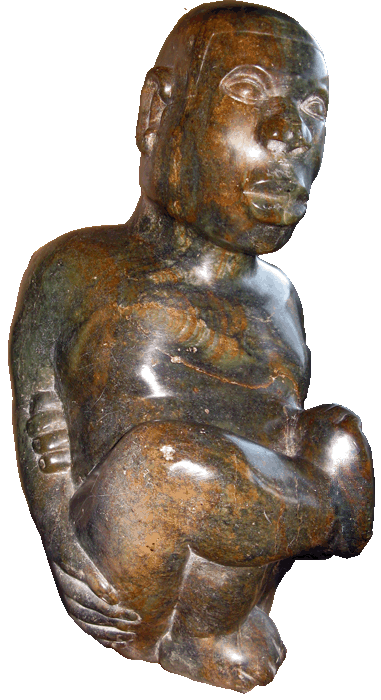
F.Vanji
Cross-Legged Man (55cm)
When Bernard, on his way to join me for our fieldwork in Kenya, visited Rhodesia in 1970, Frank McEwen, Director of the National Gallery in Salisbury (now Harare), invited him to Vukuta, in the Eastern Highlands, where Frank had gathered a group of sculptors. Bernard bought two large sculptures, including this powerful Cross-Legged Man
(b) Wood
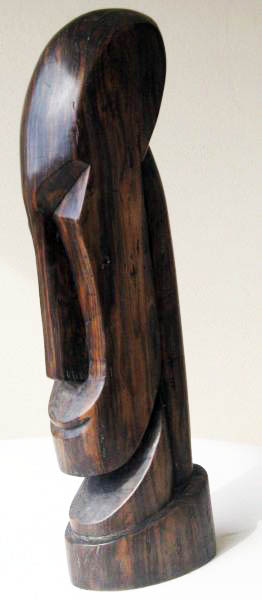
Dr.Oku Ampofo
African head (50 cm)
When I was doing fieldwork in Ghana, I became friendly with Dr.Oku Ampofo, a remarkable man who was not only a renowned physician, but also an expert in indigenous medicine - he founded CRSTM, The Centre for Scientific Research on Traditional Medicine, an impressive institution. Oku, a well-known sculptor, gave me a carved African head.
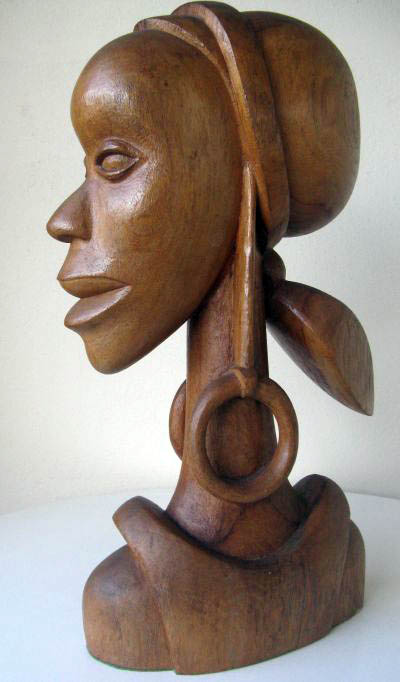
Samuel Wanjau
Night Club Doll (57
cm)
Samuel Wanjau is a well-known Kenyan sculptor; we bought Night Club Doll at the Paa ya Paa gallery, Nairobi, in 1972.

Fish (20 cm length)
In 1986 Bernard and I were walking from the charmingly colonial Victoria Falls Hotel to see the Falls, when a young vendor pleaded with us to buy one of his carvings. When he noticed that I was admiring his Fish, he offered it to me for ten shillings. I was not keen to acquire it, because of the trouble taking it back to California, but on our return from the Falls, I could not resist him when he said "you promised me: please buy it". I am glad that we have it, it is a jolly piece.

Four Igbo heads (12 cm)
On the front wall of our living room, next to the Victoria Falls fish, hang four Igbo heads from eastern Nigeria, which a have a strange oriental appearance. We bought these in 1962/63, when Bernard had joined me at the University of Ghana , Legon. On Saturday mornings we would often be visited by Bala, an itinerant Hausa trader, followed by a boy carrying an enormous bundle of his wares, mostly cloth and carvings and metal work. Bala always told us that each piece was very old, very valuable, but in fact everything was recently made - and some were very attractive. Bala would reduce his prices when he needed money to bet at the Saturday afternoon horse races.

Zimbabwe
Owl (18 cms)
When Niki Jazdowska, our Polish-Zimbabwean friend, was coming to Cape Town to stay with me, she went to see a curio-seller, whom she knew, to buy a present for me. This was in June 2005, at the time of the Murambatsvina, "Operation Drive out the Trash", when President Mugabe's thugs drove out more than one million people living in "informal settlements" in the towns and cities of Zimbabwe. Niki had just chosen a wooden Owl when a bulldozer rolled up and crushed the seller's stand. So this Owl is special, having been saved from destruction. My parish priest, Father Bram, borrowed this Owl for his Christmas Nativity scene, joining the traditional lambs. (He also has a penguin in the scene, representing our penguin colony nearby).
(c) Miscellaneous

Joseph Addeta
Dolphins leaping (15cm)
When we retired from the University of California, Santa Barbara, in 1989, our colleagues at the Environmental Studies Program gave us a cold cast bronze, by Joseph Addeta, of Dolphins Leaping. An inscription on the base reads: To David and Bernard, In Appreciation. As we regularly see dolphins in Fish Hoek Bay, this is an appropriate gift.

Stone hand coolers were common in the 18th and 19th centuries. Egg-shaped, these were carried in the palms of ladies' hands, so that they could present a lady-like cool hand, when shaking hands. Bernard had collected about 100 stone eggs (now a popular décor item) from all over the world. I can recall purchases in Brazil, India, Britain, Tasmania, the US, South Africa. I now wish that I had asked Bernard to identify them: he knew where each egg was acquired, and what the stone was.
FUELWOOD

Women gathering firewood ( 40 x 100)
In the 1970s, Bernard and I spent several periods in Kenya, making a study of social and ecological change in one rural area, Mbeere (near Embu). Part of our fieldwork involved looking at "the other energy crisis" - fuelwood. We were interested in problems caused by the increasing shortage of firewood, of the effects of deforestation and of large-scale charcoal making; This led us to acquire a few depictions. After searching several Indian shops in Mwindi Mbingu Road, Nairobi, we eventually found a batik, Women gathering firewood.

Old lady carrying firewood (18 cm)
On a visit to Uganda we bought Old lady carrying firewood; this banana-leaf figure is very simple, but also eloquent, representing a familiar sight on rural roads. We have two fuelwood paintings from further afield. Peter Castro, whose fieldwork in Kenya also involved him in fuelwood studies, gave us a tiny Mexican painting, Collecting fuelwood.
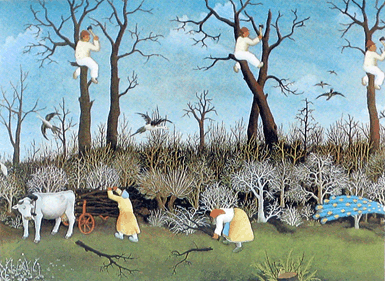
Mexico - Collecting fuelwood (7 x 10 cm)
This scene is unusual because men are also working - cutting branches in the trees, for the women below to gather. In the 1970s, Peter and I were in the National Gallery in Washington D.C., and we were amused to note that we were both drawn to a tiny detail in one large painting: simultaneously, we exclaimed "Look at the women carrying firewood". That women should collect and carry the firewood - often a heavy burden, as here - seems to be universally accepted.

Yeri Jaklitoch
Gathering firewood, (40 x 35 cm)
Finally, when we went on an Alaskan cruise, in 1988, we went ashore at Sitka, where we found Yeri Jaklitoch's powerful print, Gathering firewood. The artist is an Inuit woman.
Miscellaneous:-
Most collectors have accumulated a miscellaneous section, and we were no exception. Here are a few examples from this section.

Nautilus Shells
Nautilus shells, which were "popular items in the Renaissance cabinets of curiosities", are found on Fish Hoek beach, especially in the months of March and April. There is much competition among my early morning "Beach buddies" (Bernard's term) to find these rare shells. And the sea gulls also pose a challenge: they will pick them up, then drop them hoping that the shells will break open and expose a delicacy. However, I have managed to find four Nautilus shells, plus one that my niece Judy found, and one (the largest) given to me by generous Beach Buddy Stan. As well as being beautiful to regard, they seem to have mystical properties, so unlike most other sea shells.

Caithness Glass paper-weights
We bought these in the early days of Caithness Glass, which was founded by Robin Sinclair in 1961. On our frequent visits to Caithness (right in the north-east corner of Scotland), we made an excursion to the Factory near Wick, buying both paperweights and wine glasses, mostly "seconds", whose imperfections were barely visible; two glasses survive. My niece Deirdre found a special paperweight, made by Paul Ysart. Somehow, this treasured piece disappeared on one of our many moves. On a visit to the Corning Glass Museum, in upstate New York, in 2006, I was delighted to see that Ysart was properly appreciated, with some choice examples of his exquisite work.
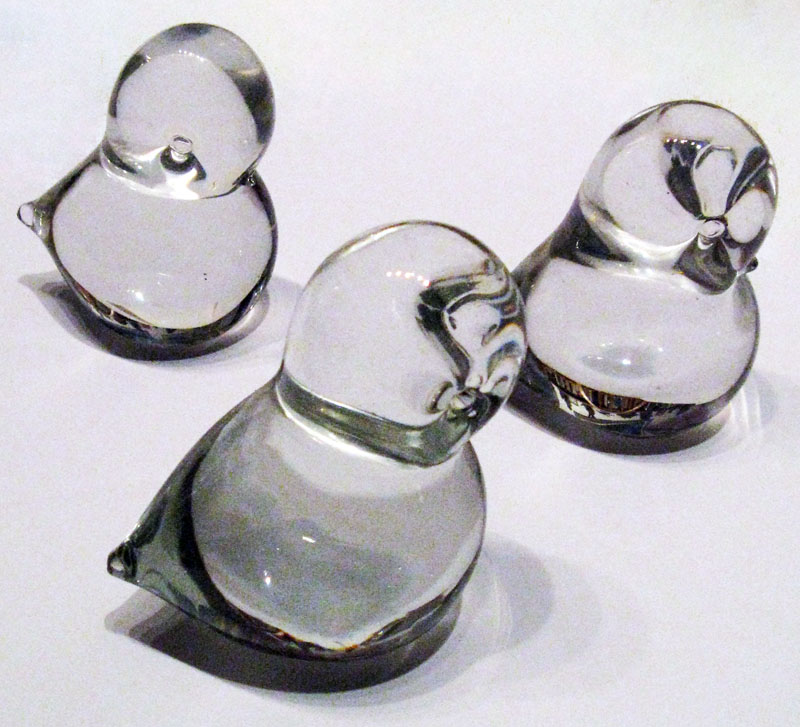
Orrefors Glass birds
We inherited these jolly Swedish items in Dwight Gilmour's estate, and and they continue to please me, especially when the sun catches them.

Toucans
The two Toucans are truly “airport art” (a term coined by Frank McEwen) in that I bought them at San Paulo airport shortly before my departure in 2004. I wandered into the airport Gift Shop, seeking a small item, on which to spend my remaining Brazilian reals : the toucans whispered “Buy us”, so I did. This was my first long solo trip after Bernard’s death; it was a test, to see if I could manage on my own: I did well, encouraged by knowing that, if I failed, I would be letting Bernard down. Fr.Bram borrowed the toucans (as well as my Owl) for the Christmas crib. Bernard and I were so excited when we saw our first toucans, in Costa Rica, in 1978. Bernard, who loved corny rhymes, recited the famous Guinness slogan: The Toucans aren’t loquacious birds, their beaks are just too big for words. Guinness they say, is good for you, so why not see what Toucan do.

Judy Homan
Collage for DWB’s 80th birthday. (70 x 52 cm).
My niece Judy has made several collages for me – others celebrated: Our 40th anniversary; Bernard’s life; Family Reunion in 2006. She is very accomplished, I was so proud of her when Marilyn Martin, then Director of the South African National Gallery, came to look at our art collection, most of which (the museum-quality items) we wished to bequeath to the Gallery. (The Gallery accepted our offer.) Marilyn noticed this collage, asking “Who did it? Does she live in Cape Town?” When I told Marilyn that Judy lived in KwaZulu/ Natal, she said “Pity; we could have used her at the Gallery”.

Ghanaian fertility dolls (Akua’maa)
I acquired these (one made by Dr.Oku Ampofo) in the early 1960s. Originally, they were intended for women wishing to conceive, but today they are among the most popular items that tourists buy in Ghana.

Wooden panel (120 x 30 cm)
Bernard and I bought this in Lilongwe market, in 1984, when we were attending a FAO (Food and Agriculture Organisation of the United Nations) workshop on “social forestry” in Malawi. Later, Bernard castigated himself, saying that we should have been more environmentally conscious – we had contributed to the loss of increasingly rare hardwood trees: this is carved out of a beautiful ironwood tree, and it depicts men fighting, and women working.
-oo0oo-
Well, Baron Rothschild would be appalled at this mish-mash of treasures and trivia, of the Sublime and the Ridiculous. “What on earth are those toucans doing here?” he would ask, plaintively. Fortunately, it is my collection, not the Baron’s. Writing this has given me much pleasure and I imagine Bernard sharing my pleasure, and saying, “Well done, Brokie!” It has also resulted in my having a CYB (Count your blessings) moment. I appreciate what a charmed life I have had, surrounded by so much love, beauty, good friends and joy – with this art collection accompanying us in our odyssey, in three continents.
(Thanks to Donald Gill, again, for his keen editorial eye, and his technical help, particularly with the photographs).
DWB Fish Hoek May 2011